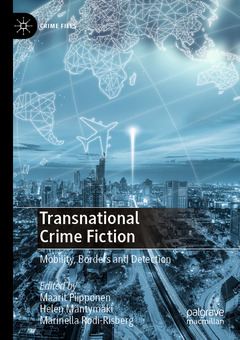Description
Transnational Crime Fiction, 1st ed. 2020
Mobility, Borders and Detection
Crime Files Series
Language: English
Publication date: 10-2021
306 p. · 14.8x21 cm · Paperback
Publication date: 10-2020
306 p. · 14.8x21 cm · Hardback
Description
/li>Contents
/li>Biography
/li>Comment
/li>
Focusing on contemporary crime narratives from different parts of the world, this collection of essays explores the mobility of crimes, criminals and investigators across social, cultural and national borders. The essays argue that such border crossings reflect on recent sociocultural transformations and geopolitical anxieties to create an image of networked and interconnected societies where crime is not easily contained. The book further analyses crime texts? wider sociocultural and affective significance by examining the global mobility of the genre itself across cultures, languages and media. Underlining the global reach and mobility of the crime genre, the collection analyses types and representations of mobility in literary and visual crime narratives, inviting comparisons between texts, crimes and mobilities in a geographically diverse context. The collection ultimately understands mobility as an object of study and a critical lens through which transformations in our globalised world can be examined.
Chapter 1: From Mobile Crimes to Crimes of Mobility
Maarit Piipponen, Helen Mäntymäki and Marinella Rodi-Risberg
PART 1: Crime on the Move: Transnational Crime and Global Capitalism
Chapter 2: Transnational Crime in Deon Meyer’s Devil’s Peak and Santiago Gamboa’s Night Prayers
Sam Naidu
Chapter 3: Temporal, (Trans)national and Human Mobility in María Inés Krimer’s Kosher Trilogy
Carolina Miranda
Chapter 4: Abdelilah Hamdouchi’s Whitefly: Transnational Crime, Globalisation and the Arabic Police Procedural
Colette Guldimann
Chapter 5: Systemic Violence in the Borderlands: Anthony J. Quinn’s Border Angels and Alicia Gaspar de Alba’s Desert Blood
Eoin D. McCarney
Chapter 6: Transnational Female Sex Trafficking in Naia Marie Aidt’s “Women in Copenhagen,” Matt Johnson’s Deadly Game, and Stuart Neville’s Stolen Souls
Charlotte Beyer
PART 2: Historicising Mobility and Agency
Chapter 7: The Socially Mobile Female in Victorian and Neo-Victorian Mysteries
Meghan P. Nolan
Chapter 8: Liminal Spaces in Laurie R. King’s Touchstone and Keeping Watch
Mary Ann Gillies
Chapter 9: Urban Mobility and Technology in Carlo Lucarelli’s Almost Blue
Barbara Pezzotti
Chapter 10: Crime and Detection in a Virtually Mobile World: Tom Hillenbrand’s Drohnenland
Heike Henderson
PART 3: Genre Borderlands: Generic Mobility and Hybridisation
Chapter 11: Criminal/Liminal/Seminal: Nordic Border Crossings and Crossers in Contemporary Geopolitical Television
Robert A. Saunders
Chapter 12: Across National, Cultural and Ethnic Borders: The Detectives in Olivier Truc’s Reindeer Police Series
Andrea Hynynen
Chapter 13: Splatter Horror Crime: Crossing Medial Borders in Jo Nesbø’s The Snowman
Niklas Salmose
Chapter 14: Affective Estrangement and Ecological Destruction in TV Crime Series Fortitude
Aino-Kaisa Koistinen and Helen Mäntymäki
Chapter 15: Sophie Hannah’s Hurting Distance as Crime Trauma Fiction
Marinella Rodi-Risberg
Maarit Piipponen is University Lecturer in English literature at Tampere University, Finland. Her research focuses on constructions of gender and ethnicity as well as mobility and spatiality in crime fiction. She is the co-editor of Topographies of Popular Culture (2016).
Helen Mäntymäki is Senior Lecturer at the Department of Language and Communication Studies at the University of Jyväskylä, Finland, where she teaches English literature and culture. Her main research interests include violence, gender and species in crime fiction.
Marinella Rodi-Risberg is Affiliated Researcher, Department of Language and Communication Studies, University of Jyväskylä, Finland, and has published on representations of trauma in journals and books including Critique: Studies in Contemporary Fiction, Studies in the Novel and Trauma and Literature (2018).
Combines the study of crime narratives with mobilities research
Highlights an increased geographical diversification of crime fiction
Examines crimes across borders, global flows of capital, the expansion and curtailment of human mobility, transnational spaces of production and consumption, and the mobilization of affects and emotions
These books may interest you

Alternative Criminologies 55.07 €



